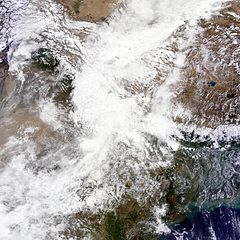
Back Inundaciones del norte de India de 2013 Spanish سیل ۲۰۱۳ شمال هند Persian उत्तर भारत बाढ़ २०१३ Hindi Banjir India Utara 2013 ID ಕೇದಾರನಾಥ ಮತ್ತು ಪ್ರಕೃತಿ ವಿಕೋಪ Kannada വടക്കേ ഇന്ത്യയിലെ പ്രളയം, 2013 Malayalam २०१३ उत्तर भारत पूर Marathi महकाली बाढी २०७० Nepali Наводнения в Индии (2013) Russian 2013 வட இந்திய வெள்ளம் Tamil
 NASA satellite imagery of Northern India on 17 June, showing rainclouds that led to the disaster | |
| Location | Uttarakhand Himachal Pradesh Uttar Pradesh Nepal Sudurpashchim Pradesh Karnali Pradesh Some parts of Tibet |
|---|---|
| Deaths | 6,054[1] |
| Property damage | 4,550 villages were affected [2] |
In June 2013, a mid-day cloudburst centered on the North Indian state of Uttarakhand caused devastating floods and landslides, becoming the country's worst natural disaster since the 2004 tsunami. The rainfall received that month was far greater than the rainfall the state usually received. Debris blocked the rivers, causing major overflow. The main day of the flood was 16 June 2013.
Though some parts of Himachal Pradesh, Haryana, Delhi and Uttar Pradesh in India experienced the heavy rainfall, some regions of Western Nepal and some parts of Western Tibet also experienced heavy rainfall. Over 89% of the casualties occurred in Uttarakhand. As of 16 July 2013[update], according to figures provided by the Government of Uttarakhand, more than 5,700 people were "presumed dead."[3] This total included 934 local residents.[4] The death toll was later placed at 6,054.[1]
Destruction of bridges and roads left about 300,000 pilgrims and tourists trapped in the valleys leading to three of the four Hindu Chota Char Dham pilgrimage sites.[5][6][7][8][9][10][11] The Indian Air Force, the Indian Army and paramilitary troops evacuated more than 110,000 people from the flood-ravaged area.[6]
- ^ a b UN Office for Disaster Risk Reduction; Centre for Research on the Epidemiology of Disasters. "Human cost of disasters - An overview of the last 20 years 2000-2019" (PDF). Archived (PDF) from the original on 28 April 2022. Retrieved 26 January 2022.
- ^ Kumar, Siddhartha (15 July 2013). "5,748 feared dead after India floods". IOL News. Archived from the original on 4 October 2013. Retrieved 19 September 2013.
- ^ "India raises flood death toll to 5,700 as all missing persons now presumed dead". CBS News. 16 July 2013. Archived from the original on 17 July 2013. Retrieved 16 July 2013.
- ^ "India says 5,748 missing in floods now presumed dead" Archived 3 August 2013 at the Wayback Machine, Fox News, 15 July 2013
- ^ Kala, C. P. (2014). "Deluge, tire disaster and development in Uttarakhand Himalayan region of India: Challenges and lessons for disaster management". International Journal of Disaster Risk Reduction. 8: 143–152. doi:10.1016/j.ijdrr.2014.03.002.
- ^ a b "Uttarakhand: Army Commander walks with 500 people out of Badrinath". NDTV.com. Archived from the original on 24 June 2021. Retrieved 16 June 2021.
- ^ "Uttarakhand, Himachal Pradesh battered by rain: death toll rises to 130, more than 70,000 stranded". NDTV. 19 June 2013. Archived from the original on 20 June 2013. Retrieved 19 June 2013.
- ^ "Heavy rain lashes north India, 50 killed". The Times of India. 18 June 2013. Archived from the original on 21 June 2013. Retrieved 19 June 2013.
- ^ Cite error: The named reference
Kedarnath HTwas invoked but never defined (see the help page). - ^ Chandramohan, C.K. (23 June 2013). "Uttarakhand floods: Over 10,000 rescued amidst misery and devastation". The Hindu. Chennai, India. Archived from the original on 26 June 2013. Retrieved 24 June 2013.
- ^ "India Intensifies its Rescue Efforts". The Wall Street Journal. 23 June 2013. Archived from the original on 30 May 2015. Retrieved 24 June 2013.